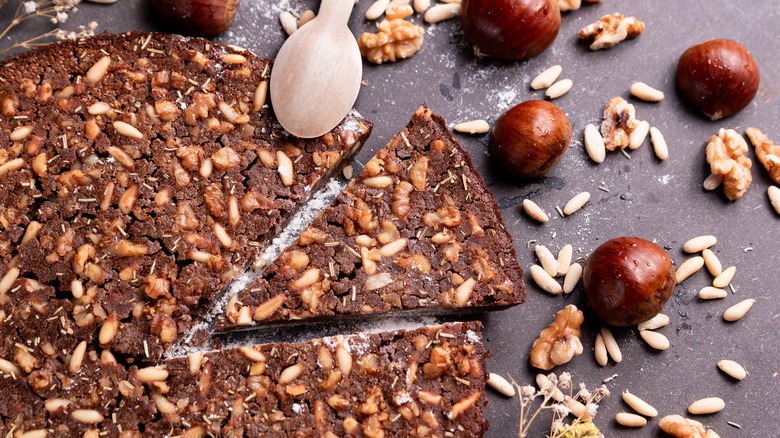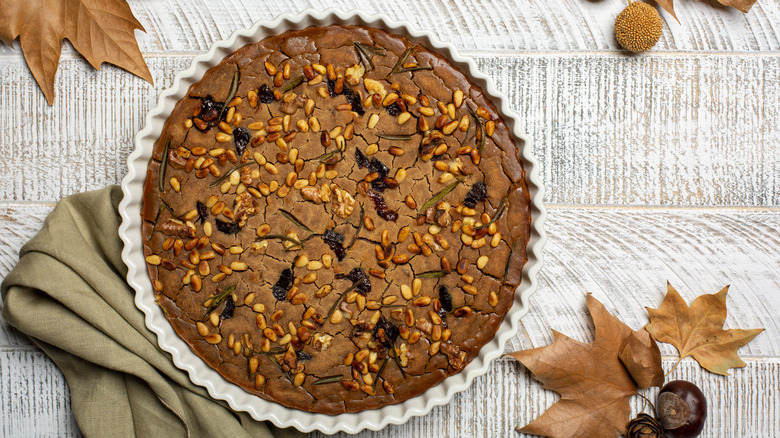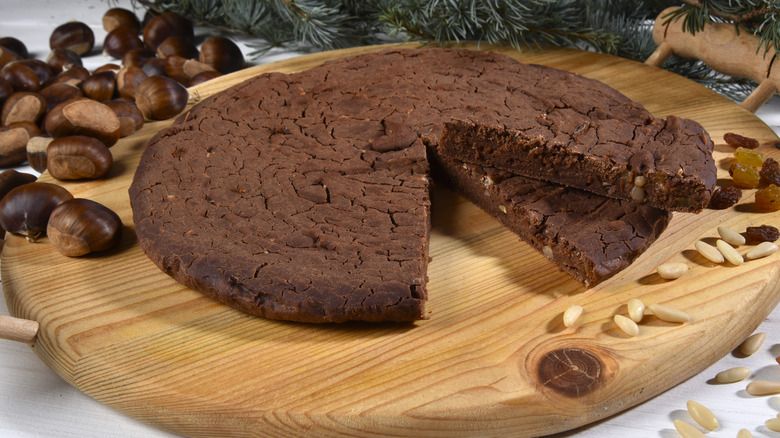Chestnuts Shine In Italy's Castagnaccio Dessert
Roasted on an open fire at Christmastime is far from the only way to crack into the mighty chestnut. Particularly in Italian culture, these just-shy-of-a-golf-ball-sized tree nuts show up in dishes from breakfast to dinner to dessert, from the northern parts of the peninsula to the southernmost areas of the Sicilian island. And while you can certainly satisfy just about any craving with a chestnut-based creation, one in particular truly highlights the deliciousness and versatility of this ingredient: Castagnaccio.
This unleavened "cake" from Tuscany more closely resembles a fruitcake in its dense bite and ingredient list. While you may find occasional variations and updates, traditionally, this treat is made with only a few items precious to Italian culture: chestnut flour, raisins, pine nuts, walnuts, rosemary, and olive oil. It's lightly sweet and a touch savory, packed with flavor,.
An added bonus? This classic recipe just so happens to be both vegan and gluten free and doesn't call for a single spoonful of sugar, so whether you're whipping one up for your own purposes, or planning to feed guests, you can count on it to satisfy a number of dietary specificities without any need to modify.
Castagnaccio's humble origins
Because it is part of Italy's "cucina povera" — a category of foods born from the resourcefulness of the peasant classes — this cake makes use of inexpensive, available, and seasonal ingredients. Chestnuts, which are abundant in the fall, found their way into many dishes for their nutritional value, and though castagnaccio is quite filling and was originally designed by poor populations to be a sustaining snack for long work days or journeys, that doesn't mean they neglected flavor.
While some contemporary versions have been updated with the addition of sugar or honey, or even Vin Santo (a classic Tuscan sweet wine) for the modern palate and pantry, traditionally, there's no sugar added to castagnaccio. This is no doubt in part because the chestnuts themselves are so naturally sweet and tasty, but also likely because those who originated this dish seemingly didn't have extra cash for pricey inclusions.
Historically, the nuts were collected from the forest floor and dried for more than a month before being ground into flour. Today, you can find chestnut flour in more commonly visited places, like the aisles of your supermarket. Because of the simplicity of this dish, however, it's important that your flour be high quality and fresh, since that will make up much of the cake's unforgettable and unique flavor.
Customizing castagnaccio
Making castagnaccio these days doesn't require foraging. In fact, it's easy to concoct simply by combining the chestnut flour with water in a bowl, then stirring in wine-soaked raisins, pine nuts and walnuts, and pouring into a generously olive-oiled pan to bake, all topped with rosemary and more nuts for garnish.
Enjoying castagnaccio is a piece of cake, too. It's commonly found around the holidays as a special, festive dessert, but it's also delicious at breakfast, paired with coffee or a flavored espresso drink like a caramel brûlée latte. You can also incorporate it into an aperitivo spread, as it pairs beautifully with cheeses from Parmigiano-Reggiano to Gorgonzola, as well as charcuterie like prosciutto or finocchiona (salami flavored with fennel), and a glass of prosecco. Much like with other chestnut cake recipes, seasonal fruits like pears or persimmons make an ideal complement on the plate, too.
You can also find castagnaccio in a variety of flavors these days, particularly as you move through the peninsula; different regions will play with their own prized ingredients. At home, swap Vin Santo for another wine, or even a spirit like gin or whiskey; exchange your selection of nuts and try hazelnuts or pistachios in place of pine and walnuts, dried figs or cranberries instead of raisins, or add fennel seeds or similar. Chocolate isn't unwelcome in this cake either, and you can mix cocoa powder into the batter, or drizzle with chocolate and serve.


